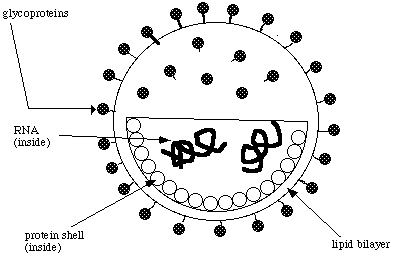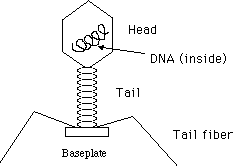Microorganisms
- Host and often tissue specificity
- Contain either DNA or RNA but not both.
- RNA viruses usually contain enzymes for replicating their RNA since cells have no native enzymes for copying RNA.
- Different viruses can infect animals, plants, and bacteria. Bacterial viruses are also known as bacteriophages or phages.
- Virus attaches to cell wall
- Virus injects its DNA into cell
- The DNA is replicated and transcribed into mRNA repeatedly using enzymes and substrates of the cell
- mRNA is translated into proteins
- Self-assembly of new viruses using the new DNA and protein
- New viruses begin digesting cell wall
- Cell swells and bursts, releasing the viruses
- Viruses attach to other cells
- Virus attaches to cell membrane
- Viral envelope merges with cell membrane
- Single-stranded RNA released into cell
- Single-stranded DNA transcribed from this using reverse transcriptase
- Complementary DNA strand synthesized using the single-stranded DNA as a template
- The double-stranded DNA is incorporated into the cell's genome (this DNA is called a provirus)
- Viral genes are transcribed into mRNA, which are then translated into viral proteins or are packaged as genetic material in new viruses
- New viruses, complete with RNA, reverse transcriptase, capsids, and envelopes, exit the cell and find other cells to infect
Viruses
Viruses are obligate intracellular parasites since they can reproduce only in a host cell. An isolated virus cannot replicate itself. In fact, the only thing it can do is infect an appropriate host cell. Isolated viruses are merely protein-coated sets of genes in transit from one host cell to another.
The protein coat is called a capsid. Some viruses also have an envelope surrounding the capsid that is derived from the host's cell membrane.
Some other features of viruses:
Differences between Bacteriophages and Animal Viruses
| Bacteriophage structure
| HIV structure |
Bacteriophages |
Animal Viruses | |
Attachment sites on virus | Sites that attach to cells are located on the tail | Sites that attach to cells are distributed over the entire surface of the capsid or envelope |
Method viral genome transferred to host | DNA is injected into host. Usually capsid and tail left outside. | Virus usually taken in toto into host's cytoplasm |
|
|
|
Simplified Life Cycle of a DNA Bacteriophage Virus
Retroviruses
Retroviruses are a class of virus that reproduce by transcribing their RNA into DNA. Isolated retroviruses contain the enzyme reverse transcriptase for this purpose since host cells lack this enzyme. Retroviruses include many cancer-causing viruses as well as the virus that causes AIDS, the human immunodeficiency virus (HIV).
Below is a simplified life cycle of the HIV virus.
The Five Kingdoms
| Kingdom | Examples |
| Monera | Bacteria |
| Protista | Amoeba, paramecium, algae |
| Fungi | Mushrooms, molds |
| Plants | Mosses, spruce |
| Animals | Hydra, humans |
Gene Transfer in Bacteria
Natural selection depends on genetic diversity. Mutations are one way of producing genetic diversity. In animals, plants, and fungi, genetic diversity is also created through meiosis and sexual reproduction. However, bacteria reproduce by binary fission, an asexual process. Since they do not reproduce sexually, they have evolved other means of creating genetic variation in their offspring.
Conjugation - The transfer of genetic material from one cell to another via a temporary mating bridge. The "male" transfers DNA to the "female" and not vice versa.
Transduction - The transfer of genetic material from one cell to another via a virus.
Transformation - The assimilation of external genetic material by a cell.
Fungi
- The fungi are a kingdom of organisms. They are eukaryotic, primarily multicellular, lack flagella, and most have cell walls made of chitin (a structural polysaccharide). All are heterotrophs, acquiring nutrients by absorption. They digest their food by secreting hydrolytic enzymes.
Fungi consist mostly of hyphae, which branch and form a net-like structure called a mycelium. Most fungi have their hyphae partitioned into cells, although some are coenocytic (i.e. aseptate).
Fungi reproduce by dispersing great numbers of spores, which germinate into hyphae. Early reproduction is usually asexual, with the haploid state persisting throughout. Later reproduction is sexual: cell fusion occurs forming a diploid cell, which undergoes meiosis to form haploid spores. Thus, genetic variation is introduced.
Differences between Viruses, Prokaryotes, and Eukaryotes
| Viruses | Prokaryotes | Eukaryotes |
| 0.02 - 0.04 microns (transmission electron microscopy required) | Less than 1 micron to 3 microns | 5 to 100 microns |
| No membranes | Plasma membrane but no nuclear membrane, etc. | Plasma membrane, nuclear membrane, membranes of various organelles |
| Lack metabolic & reproductive machinery | Opposite | Opposite |
| No ER or ribosomes | No ER. Ribosomes are "free." | Have ER. Some ribosomes "free"; others attached to ER. |
| N/A | Transcription & translation are simultaneous | Transcription & translation not simultaneous |
| No histones* | No histones | Histones |
* Histones are proteins found in chromosomes.
